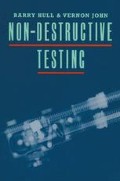Abstract
Very-short-wavelength electromagnetic radiation, namely X-rays or γ-rays, will penetrate through solid media but will be partially absorbed by the medium. The amount of absorption which will occur will depend upon the density and thickness of the material the radiation is passing through, and also the characteristics of the radiation. The radiation which passes through the material can be detected and recorded on either film or sensitised paper, viewed on a fluorescent screen, or detected and monitored by electronic sensing equipment. Strictly speaking, the term radiography implies a process in which an image is produced on film. When a permanent image is produced on radiation-sensitive paper, the process is known as paper radiography. The system in which a latent image is created on an electrostatically charged plate and this latent image used to produce a permanent image on paper is known as xeroradiography. The process in which a transient image is produced on a fluorescent screen is termed fluoroscopy, and when the intensity of the radiation passing through a material is monitored by electronic equipment the process is termed radiation gauging.
Preview
Unable to display preview. Download preview PDF.
Author information
Authors and Affiliations
Copyright information
© 1988 J. B. Hull and V. B. John
About this chapter
Cite this chapter
Hull, B., John, V. (1988). Radiography. In: Non-Destructive Testing. Palgrave, London. https://doi.org/10.1007/978-1-349-85982-5_6
Download citation
DOI: https://doi.org/10.1007/978-1-349-85982-5_6
Publisher Name: Palgrave, London
Print ISBN: 978-0-333-35788-0
Online ISBN: 978-1-349-85982-5
eBook Packages: Palgrave Economics & Finance CollectionEconomics and Finance (R0)

